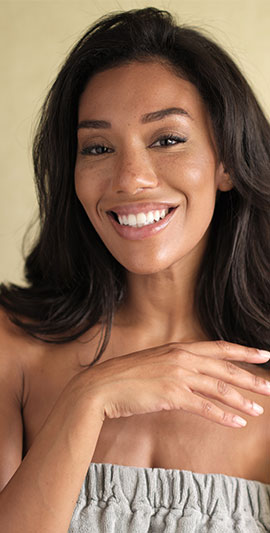There are five key factors that people of color, especially those of African descent, should know before they begin acne treatment. Considering these factors can help individuals with skin of color make informed decisions about their treatment options and obtain better results.
#1: Dark skin is prone to developing “dark spots”
These darkened spots on the skin, called “post-inflammatory hyperpigmentation,” can occur at the site of a healed or healing inflamed acne lesion. Caused by excessive melanin production, this darkening of the skin is a normal reaction when dark skin becomes inflamed, such as after a rash, scratch or pimple. They are the number one complaint among dark-skinned patients with acne. Like acne, “dark spots” can diminish one’s self-esteem and affect a person’s ability to function confidently in society.
How to treat “dark spots”
When these spots appear, they can be treated with a topical skin-lightening topical medicine or physician directed procedure.
Sunscreen may help. Sunscreen with an SPF of 15 or higher helps resolve the spots more quickly. Only sunscreen labeled “noncomedogenic” should be used. “Noncomedogenic” means the product will not clog pores.
#2: Topical Acne treatments designed to dry the skin should be use with caution
Acne medications that can have a drying effect on the skin, such as benzoyl peroxide, should only be used under the supervision of a physician because they may irritate the skin, prolong post-inflammatory hyperpigmentation or lighten the surrounding skin.
Topical acne medications for skin of color
Clinical studies show that some topical medications, such as retinoids, safely and effectively treat acne in skin of color when used properly. Topical retinoids, which are only available by prescription, include adapalene, tazarotene and tretinoin.
#3: Pomade may be the culprit
A recent survey of acne patients with skin of color revealed that almost half, 46.2%, use pomade (oil or ointment for hair) to style or improve the manageability of their hair and that 70.3% of the patients using pomade developed forehead acne. The acne that develops from using pomade is called “acne cosmetica” or “pomade acne.” It occurs when pomade blocks pores and acne develops on the scalp, forehead and/or temples—places where pomade comes into contact with the skin. Pomade acne usually consists of blackheads and whiteheads, with perhaps a few papules and pustules. It can also cause a condition called folliculitis.
- If using pomade to decrease scalp dryness, try applying pomade one inch behind the hairline.
- If using pomade to style or make hair more manageable, try applying pomade to the ends of the hair only to avoid contact with the scalp and hairline.
- Stop using pomade.
#4: Moisturizers can worsen acne
Moisturizers relieve the dry or “ashy skin” that is common among dark-skinned people. When using moisturizer, make sure the label includes the word “noncomedogenic.” This means the product will not clog pores.
#5: Keloid may form after acne outbreak
When scarring occurs in a person with skin of color, there is a greater tendency for a keloid (large raised scar that spreads beyond the size of the original wound) to form. While uncommon in acne patients with skin of color, keloids have been seen on the chest, back and jaw line. Early and aggressive acne treatment is needed to prevent scarring because keloids, unfortunately, tend to return even when treated.
Laser Treatments for darker skin types
Though treating patients of color often requires specialized lasers and experience, we have been very successful controlling acne in this group of patients as well.
One of the biggest advances in the area is the procedure Photodynamic therapy (PDT ALA) as well as the use of the Curelight and Blue Light Therapy.







